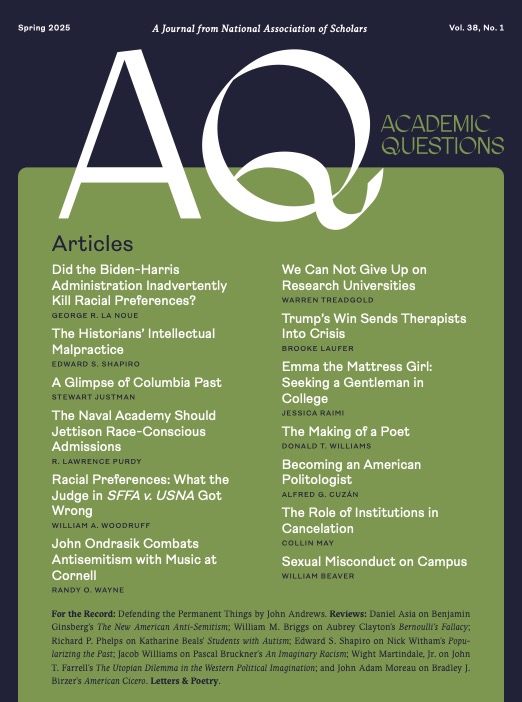When we think of cancel culture, we usually focus on two parties: the target and the cancelers. The target is the individual accused of having stated or written something that allegedly offends the sentiments of a particular identity group. The cancelers are those who call out the target and prolong the cancelation event through a process of piling on. A standard component of cancelation is the demand by the cancelers that the target pay a price for their words, that they be held accountable. This usually involves termination of employment, deplatforming, canceling speaking engagements, or some other form of public humiliation. The response to these demands engages third parties who must decide how they will react, and in doing so they can quickly become involved in acts of institutional betrayal against the target.
Drawing on the work of sociologist Harold Garfinkel, Luke Sheahan of Duquesne University has equated a cancelation event to a “degradation ceremony” in which the canceler calls out the actions of the target through a demonstration of moral indignation. This commences the “ritual destruction of the person denounced.” As Sheahan notes, the destruction involved is a literal evisceration of the target’s membership in a given society. The target’s past identities and social standing are then seen as “accidental,” as a gloss covering over their new “basic reality” which shows the target in their true and socially unacceptable light.
However, the cancelers alone cannot affect this change in the target’s social status without the cooperation of third parties—the witnesses. In general, witnesses include the entirety of a society outside the target-canceler duo. Specifically, the witnesses with the most power to harm the target are employers, speaking venue managers, publishers, etc. These witnesses possess the ability to confirm the cancelation and take definitive punitive action against the target. Given that these particular witnesses are often institutions with whom the target regularly interacts, is a member of, and trusts, actions taken by these third parties against the target usually entail a form of institutional betrayal, imposing a second level of harm on the cancelation target.
Defining Institutional Betrayal
The concept of institutional betrayal has been developed over the past few decades by Jennifer Freyd of the University of Oregon and Carly Smith of Penn State College of Medicine. My discussion of the topic will draw on their 2014 article in American Psychologist, where the authors define the term, how it manifests, and the characteristics of institutions likely to demonstrate this form of betrayal.
First, we note that the subject of the betrayal is an individual with their own specific experiences. While this may initially appear obvious and somewhat insignificant, this feature is central to understanding the dynamic involved. While the procedures that produce institutional betrayal may include a systemic element, the harm is experienced primarily by individuals in their interactions with an institution.
Second, evidence of diverse posttraumatic reactions might also be attributable to variations in the “interpersonal nature and chronicity of some abuse.” In other words, as Freyd and Smith note, “Betrayal trauma theory posits that abuse perpetrated within close relationships is more harmful than abuse perpetrated by strangers because of the violation of trust within a necessary relationship.”
This is the key insight behind betrayal trauma: that abuse from a person who would normally engender trust in the subject results in higher incidents of negative psychological affects than abuse from a non-necessary or casual relationship with an acquaintance or stranger. According to Freyd and Smith, the reason for this is based in the very coping mechanisms that individuals develop to survive this sort of abuse in light of the longer-term trust relationships involved. Whereas the victim of a car theft will likely never interact directly with the perpetrator, an abused child will be dependent on their abuser for years and will develop coping strategies that tend to support negative attachment behaviors.
The unique element Freyd and Smith introduce through their research is the application of betrayal trauma theory to institutions. As their definition suggests, the interpersonal relationship may not be between two individuals, but between the subject individual and an institution that elicits the trust of the subject and is often tasked with a protective function in relation to that subject. This can include the legal system, employers, health care providers, educational institutions, professional associations, regulators, etc. The relevant point here is that the trust relationship is now between an individual and an entire organization, often possessing significant resources or authority over the subject.
Finally, Freyd and Smith’s definition notes that the subject of abuse does not necessarily belong to a marginalized or disadvantaged group. Rather, institutional betrayal is typically random and targets isolated individuals.
Institutional Betrayal and Cancelation
Application
Applying institutional betrayal theory to a cancelation event, we note again that the party engaged in the betrayal is not the canceler or denouncer who calls out the target’s alleged offensive speech but trusted institutions that react to the cancelers’ demands. In the case of cancelation, this often involves calls to employers to terminate an employee, demands for speaking venues to deplatform an intended speaker, or pressure on publishers to withdraw support for authors.
In each of these instances, the elements of institutional betrayal are present. First, the target is usually an individual, often a public figure, writer, or academic who has tweeted or written something, even in the context of scholarly research, that a certain identity group deems objectionable. Additionally, the institution is one that the target often trusts. In the case of an employer, it is a member of the group engaging in the betrayal through termination. Further, the target is generally not chosen because they belong to a socially marginalized group, but because of their statements. Indeed, cancelation can be so toxic and persistent that it overrides consideration of the target’s own membership in a group that has suffered discrimination.
As regards the dimensions of betrayal in the context of a cancelation event, the third-party might engage in actions ranging from omissions to commissions, and they may be directed toward the individual target but include the application of organizational procedures and policies that extend the harm to the target. In the employment context, this can include abandoning an employee to the canceler’s taunts, failing to provide supports to a targeted employee, and eventually taking outright action to terminate the employee.
Turning to the characteristics of betrayal, membership in a group is often essential to a target. Indeed, it is the precise membership that cancelers seek to terminate, whether it is employment, deplatforming a speaker, or preventing a writer from publishing. Organizational prestige is also implicated in that a target is generally situated in a revered or respected profession or role, which is common in cancelation in light of the implicit need by cancelers to signal their power and moral superiority to members of their own in-group.
Barriers to prevent abuse are also present in the cancelation context, especially where respected employers, speaking venues (such as universities), or publishers are risk averse and unwilling to defend targets against the cancelers’ allegations for fear of being similarly labeled.
The Harm Imaginary
At this point, I would like to introduce a concept I have developed to describe the dynamic and mutually validating accusatory interaction occurring between the target and canceler: the harm imaginary. One of the key elements, if not the core of cancelation, is the claim that a target’s words have themselves inflicted a form of harm or injury on an identifiable group, generally one that claims a marginalized social status. The underlying notion here is that words—spoken or written—are themselves a form of violence comparable to or even submerging violent action. According to this mindset an ever-expanding domain of words becomes equivalent to actual physical violence.
In two previous essays, I addressed the psychology of the target and the canceler. As regards the target, I compared the statement/apology extorted from the target to the false confession in the context of criminal interrogation. Specifically, I noted the strong correlation between the motivation to provide a false confession by the criminally accused and the decision to draft a statement or apology by the cancelation target as they seek to assuage the harm claimed by the would-be cancelers.
As concerns the cancelers, I examined a recent study that found that cancelers, far from being motivated by an altruistic desire to improve a marginalized group’s social position, are instead engaged in virtue signalling to the initiator’s in-group. What is relevant here is that as regards actual harm, it is the target who suffers an initial psychological harm that becomes so manifest and overwhelming as to lead the individual to produce the statement/apology akin to the false confession. Similarly, the cancelers, who allege harm to themselves or a group they claim to represent, in fact suffer no true harm but rather engage in a self-confirming exercise of validation within their in-group that is relatively risk-free as there is no possibility of truly violent action against the canceler or the marginalized social group.
This dynamic, as it plays out both between the target and the cancelers, constitutes the harm imaginary. Both parties act for non-appropriate motives in accordance with an imagined harm: the one seeking to assuage the imagined harm and the other seeking to exploit it. The harm imaginary in its dichotomous dynamic, also becomes part of the mindset activating third parties who will then engage in institutional betrayal, causing substantial, and often more profound harm, to the already scarred target. Often, the third party’s infliction of secondary harm in the cancelation context comes in the form of validation of the canceler’s allegations with such validation corroborated by the target’s own statement/apology.
DARVO
One of the central concepts Freyd and Smith have developed is the DARVO technique (Deny, Accuse, Reverse Victim & Offender). This technique, often deployed by the accused where a victim claims sexual assault, functions perfectly in the cancelation context where a third-party acts upon the dynamic of the harm imaginary. Indeed, commensurate with the extortion of the statement/apology, the institution believes it is justified in further harming the target. In the cancelation context, the target assists in the denial of their own victimhood by the cancelers, effectively accusing themselves. The third-party institution, normally trusted by the target, then relies on this self-accusation as verification of the cancelers’ allegations, allowing for the morphing of the target as cancelation victim into the offender deploying speech in lieu of actual physical violence.
A Case Study in Institutional Betrayal
The Development of a Harm Imaginary
With the preceding analysis in mind, we can apply institutional betrayal theory to my own experience of cancelation as it played out when I was appointed as Chief of the Alberta Human Rights Commission (AHRC) in May 2022 by the Alberta government. At the time of my appointment, I had been serving as a part-time Commissioner with the AHRC for three years, had written over 40 published decisions, and conducted more than 40 mediations. I also had developed significant experience with secondary harm caused by inadequate or unfair complaints processes following adverse medical events, eventually resulting in my appointment as Adjunct Lecturer in Community Health Science at the University of Calgary. Given that the AHRC was a complaints-driven process, my background was integral to my appointment.
However, in early July 2022, a blogger affiliated with the opposition Alberta New Democratic Party (NDP), published an article about an academic book review I had written on Islamic imperialism in 2009. The book was written by renowned Middle East historian, Efraim Karsh, and published by Yale University Press. The cancelers in this instance included the blogger, as well as members of the NDP caucus who called my writing “Islamophobic, racist, and hate speech.” Among those caucus members making these accusations were lawyers, who were members of my own professional regulator, the Law Society of Alberta.
In addition, the NDP-affiliated blogger contacted the National Council of Canadian Muslims (NCCM), who in turn contacted the Alberta government and the Office of the Alberta Premier. While there was debate in the Premier’s Office as to whether the review was problematic, as my employer, the Premier’s Office eventually made me contact the NCCM and meet with them, thereby placing me in a position of deference to one of my cancelers initiating the harm imaginary. At this early stage, I was able to survive the cancelation, but once placed at the mercy of a canceler, the goal of termination or deplatforming, is typically successful. The NCCM asked me to issue an apology to the Muslim community. I refused citing the academic nature of the review, as well as support from academic commentators including Efraim Karsh himself. But I did issue a statement in an effort to assuage the community. But as usually occurs, the NCCM ultimately found a reason to condemn my actions and called for my termination. The Alberta government capitulated on September 15, 2022.
The Law Society of Alberta and Institutional Betrayal
For our purposes, I will focus on a third-party institution that engaged in institutional betrayal in relation to my cancelation, demonstrating the applicability of the theory and the DARVO technique in the cancelation context. While there were a number of relevant institutions involved as third parties in my cancelation, I will focus on one that clearly demonstrates the application of institutional betrayal: the Law Society of Alberta (LSA).
My experience with the LSA began when I was approached by their lead investigator, following a referral from the Calgary Police Service, asking me if I wished to make a complaint against those involved in my cancelation who were also fellow members of the LSA. We determined that I would make three complaints against two NDP politicians who were also lawyers, along with a third NDP-affiliated lawyer. To preserve their anonymity, they will not be named in this essay. In terms of my three complaints, the LSA sent them to a lawyer in another jurisdiction to review. His decision was to dismiss all three complaints. I then appealed that decision to a panel of LSA benchers (the LSA’s directors of the board) who upheld the appeal. I was then informed that a third review was possible. I requested the review, but the dismissals were again upheld.
Turning to the application of institutional betrayal theory to my complaints, we can confirm that the LSA displays many of the characteristics enumerated by Freyd and Smith. First, it is an organization with a required membership in that all lawyers must belong to the LSA and pay dues to practice law in the province. Second, it is an institution that is both respected among lawyers and one that I trusted, having volunteered six of my twelve years as a lawyer on two LSA committees. Third, my treatment by the LSA did not depend on my membership in a marginalized group, though as an openly gay man, this context was relevant.
The LSA Decisions as Instances of DARVO
While there are several factors in the LSA decisions that demonstrate institutional betrayal, I will focus on two that clearly implicate betrayal theory in the context of a third-party response to my cancelation.
The first concerns the evidence considered by the lawyer who originally dismissed my complaints, especially as regards the two NDP politicians. While I provided substantial evidence, the decision-maker focused primarily on the content of my book review to justify the politicians’ onslaught while ignoring the support from the academic community. Additionally, the decision-maker placed significant emphasis on the statement I had written under pressure from the NCCM and the Alberta government. In terms of the decision, my statement was deployed as a weapon against me, supposedly demonstrating my own awareness that my book review was, if not offensive, then at least problematic.
The goal was to provide justification for the politicians’ condemnations directed at me by activating the harm imaginary dynamic as described above. Indeed, this element of the decision was a quintessential example of the harm imaginary process in operation. In my case, the third-party LSA verified the cancelers’ own in-group virtue signaling using my extorted statement as self-inflicted indictment. The LSA became an ally in my cancelation as it entered into the harm imaginary dynamic, confirming the non-existent harm allegedly suffered by the canceling in-group while fully ignoring the real harm caused to my reputation and livelihood by the cancelation. And given the characteristics of the LSA as a membership-based organization with substantial power over me, the LSA’s decision perfectly reflected the elements of institutional betrayal in the cancelation scenario.
Moreover, the harm imaginary dynamic was confirmed and solidified in the subsequent appeals decision that upheld the dismissal of my complaints. In a key finding, the appeals panel stated that it agreed with the contention of one of the NDP politician’s lawyer to the effect that a review of the timeline of events, specifically my drafting of the extorted statement, demonstrated, “the degree to which Mr. May himself is to blame for his predicament.”
Here we see a classic example of the DARVO principle at work as it reinforces the harm imaginary process. While I was the victim of the cancelation attack and the only person who ultimately suffered any real harm, the LSA denied this palpable harm and reversed the victim-offender roles by allying itself with the cancelers using my extorted statement as evidence of my guilt. And it is in this recurring pattern that we observe the harm imaginary engaged as it implicates the third-party witness into the circle of the cancelers’ virtue signalling condemnation and the target’s self-incrimination through the extorted statement/apology. Further, considering the relationship of trust and dependency between the LSA as an institution and myself as a member, the elements of institutional betrayal come clearly to the fore.
Conclusion
As we have seen, in the cancelation context, the third-party institution becomes an active participant in the cancelation event through the harm imaginary dynamic. In the interplay of the target’s extorted statement/apology and the canceler’s in-group virtue signalling, the third-party, whether an employer, professional regulator, publisher, or other trusted organization, validates the accusatory cycle. In doing so, the institution employs techniques such as the DARVO mechanism against the target thereby enacting its role in Freyd and Smith’s institutional betrayal pattern. The target, having been initially harmed by the canceler’s onslaught, is subjected to secondary harm and betrayal by the trusted third-party institution with all its attendant psychological disorders.
Collin May is a lawyer in Calgary, Alberta; an adjunct lecturer in community health sciences with the Cumming School of Medicine at the University of Calgary, and an author of a number of academic reviews and articles. May last appeared in AQ in the fall of 2024 with his article “Confessions of the Canceled: The Psychology of Cancel Culture.”
Photo by Markus Winkler on Unsplash














